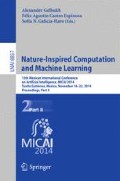Abstract
We are still not in a position to understand most of the brain’s deeper computational properties. As a consequence, we also do not know how brain processes are affected by nerve cell deaths in neurodegenerative diseases (ND). We can register symptoms of ND such as motor and/or mental disorders (dementias) and even provide symptomatic relief, though the structural effects of these are in most cases not yet understood. Fortunately, with early diagnosis there are often many years of disease progression with symptoms that, when they are precisely monitored, may result in improved therapies. In the case of Parkinson’s disease, measurements of eye movements can be diagnostic. In order to better understand their relationship to the underlying disease process, we have performed measurements of reflexive eye movements in Parkinson’s disease (PD) patients. We have compared our measurements and algorithmic diagnoses with experts’ diagnoses. The purpose of our work was to find universal rules, using rough set theory, to classify how condition attributes predict the neurologist’s diagnosis. Prediction of individual UPDRS values only from reflexive saccade (RS) latencies was not possible. But for n = 10 patients, the patient’s age, latency, amplitude, and duration of RS gave a global accuracy in individual patients’ UPRDS predictions of about 80%, based on cross-validation. This demonstrates that broadening the spectrum of physical measurements and applying data mining and machine learning (ML) can lead to a powerful biomarker for symptom progression in Parkinson’s.
Access this chapter
Tax calculation will be finalised at checkout
Purchases are for personal use only
Preview
Unable to display preview. Download preview PDF.
References
Przybyszewski, A.W.: The Neurophysiological Bases of Cognitive Computation Using Rough Set Theory. In: Peters, J.F., Skowron, A., Rybiński, H. (eds.) Transactions on Rough Sets IX. LNCS, vol. 5390, pp. 287–317. Springer, Heidelberg (2008)
Przybyszewski, A.W., Gaska, J.G., Foote, W., Pollen, D.A.: Striate cortex increases contrast gain of macaque LGN neurons. Visual Neuroscience 17, 1–10 (2000)
Przybyszewski, A.W.: Logic in Visual Brain: Compute to Recognize Similarities: Formalized Anatomical and Neurophysiological Bases of Cognition. Review of Psychology Frontier 1, 20–32 (2010) (open access)
Przybyszewski, A.W.: Logical rules of visual brain: From anatomy through neurophysiology to cognition. Cognitive Systems Research 11, 53–66 (2012)
Pizzolato, T., Mandat, T.: Deep Brain Stimulation for Movement Disorders. Frontiers in Integrative Neuroscience 6, 2 (2012), doi:10.3389/fnint.2012.00002
Pawlak, Z.: Rough sets: Theoretical aspects of reasoning about data. Kluwer, Dordrecht (1991)
Bazan, J., Son, N.H., Trung, T., Nguyen, S.A., Stepaniuk, J.: Desion rules synthesis for object classification. In: Orłowska, E. (ed.) Incomplete Information: Rough Set Analysis, pp. 23–57. Physica – Verlag, Heidelberg (1998)
Bazan, J., Szczuka, M.: RSES and RSESlib - A Collection of Tools for Rough Set Computations. In: Ziarko, W.P., Yao, Y. (eds.) RSCTC 2000. LNCS (LNAI), vol. 2005, pp. 106–113. Springer, Heidelberg (2001)
Author information
Authors and Affiliations
Editor information
Editors and Affiliations
Rights and permissions
Copyright information
© 2014 Springer International Publishing Switzerland
About this paper
Cite this paper
Przybyszewski, A.W., Kon, M., Szlufik, S., Dutkiewicz, J., Habela, P., Koziorowski, D.M. (2014). Data Mining and Machine Learning on the Basis from Reflexive Eye Movements Can Predict Symptom Development in Individual Parkinson’s Patients. In: Gelbukh, A., Espinoza, F.C., Galicia-Haro, S.N. (eds) Nature-Inspired Computation and Machine Learning. MICAI 2014. Lecture Notes in Computer Science(), vol 8857. Springer, Cham. https://doi.org/10.1007/978-3-319-13650-9_43
Download citation
DOI: https://doi.org/10.1007/978-3-319-13650-9_43
Publisher Name: Springer, Cham
Print ISBN: 978-3-319-13649-3
Online ISBN: 978-3-319-13650-9
eBook Packages: Computer ScienceComputer Science (R0)

